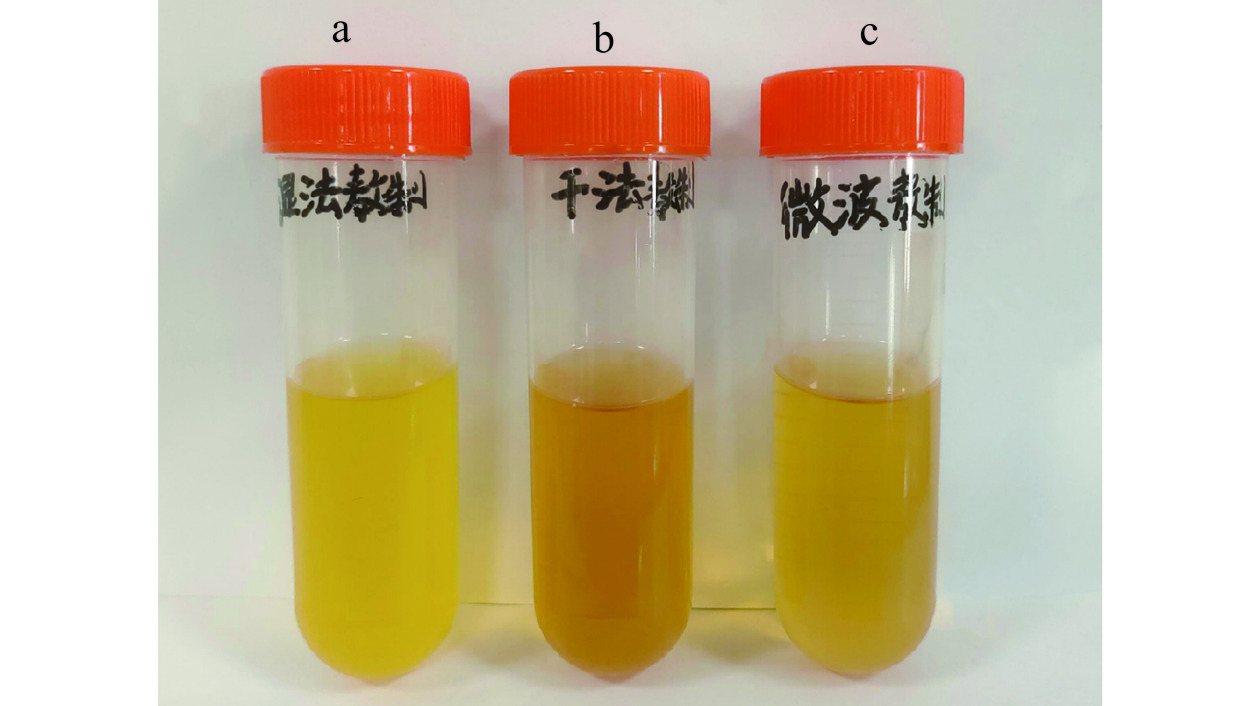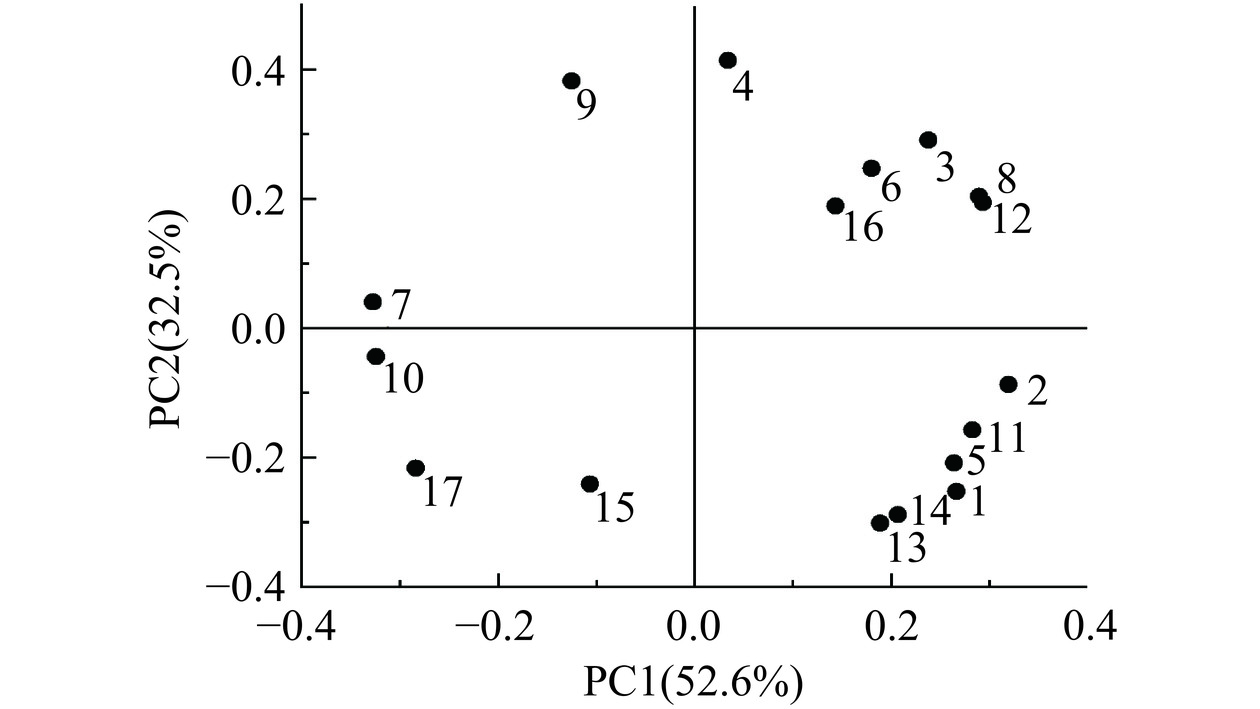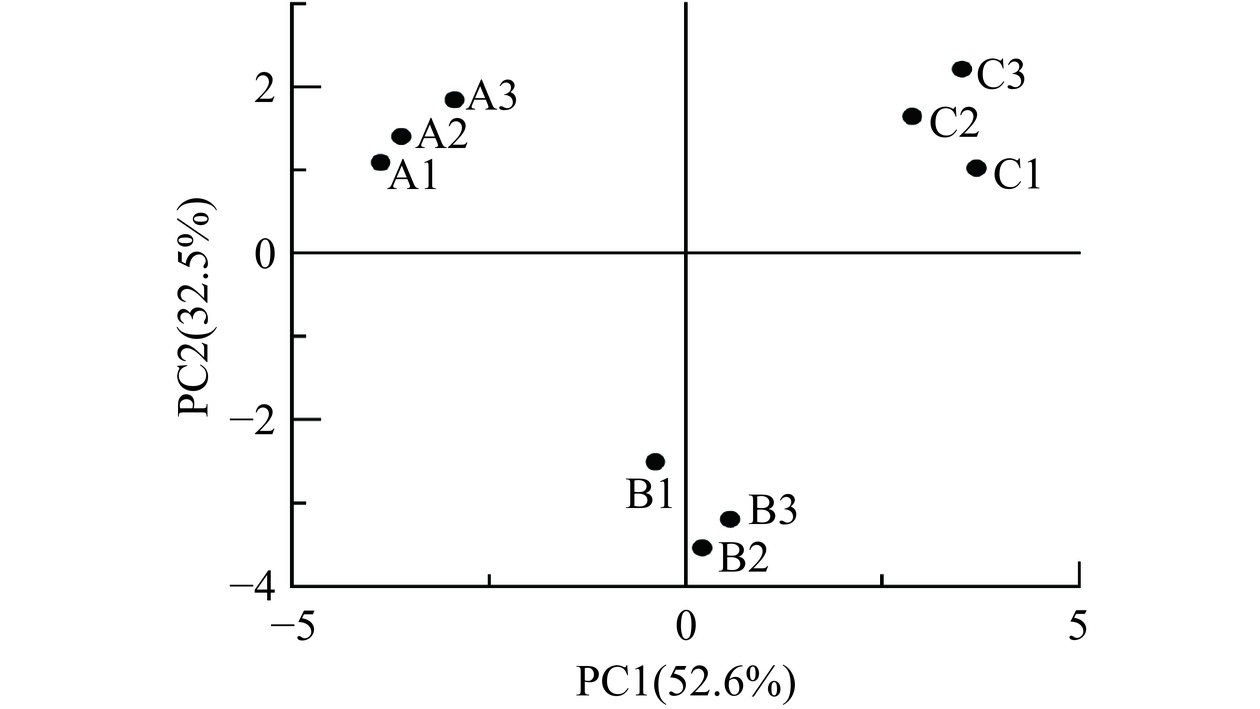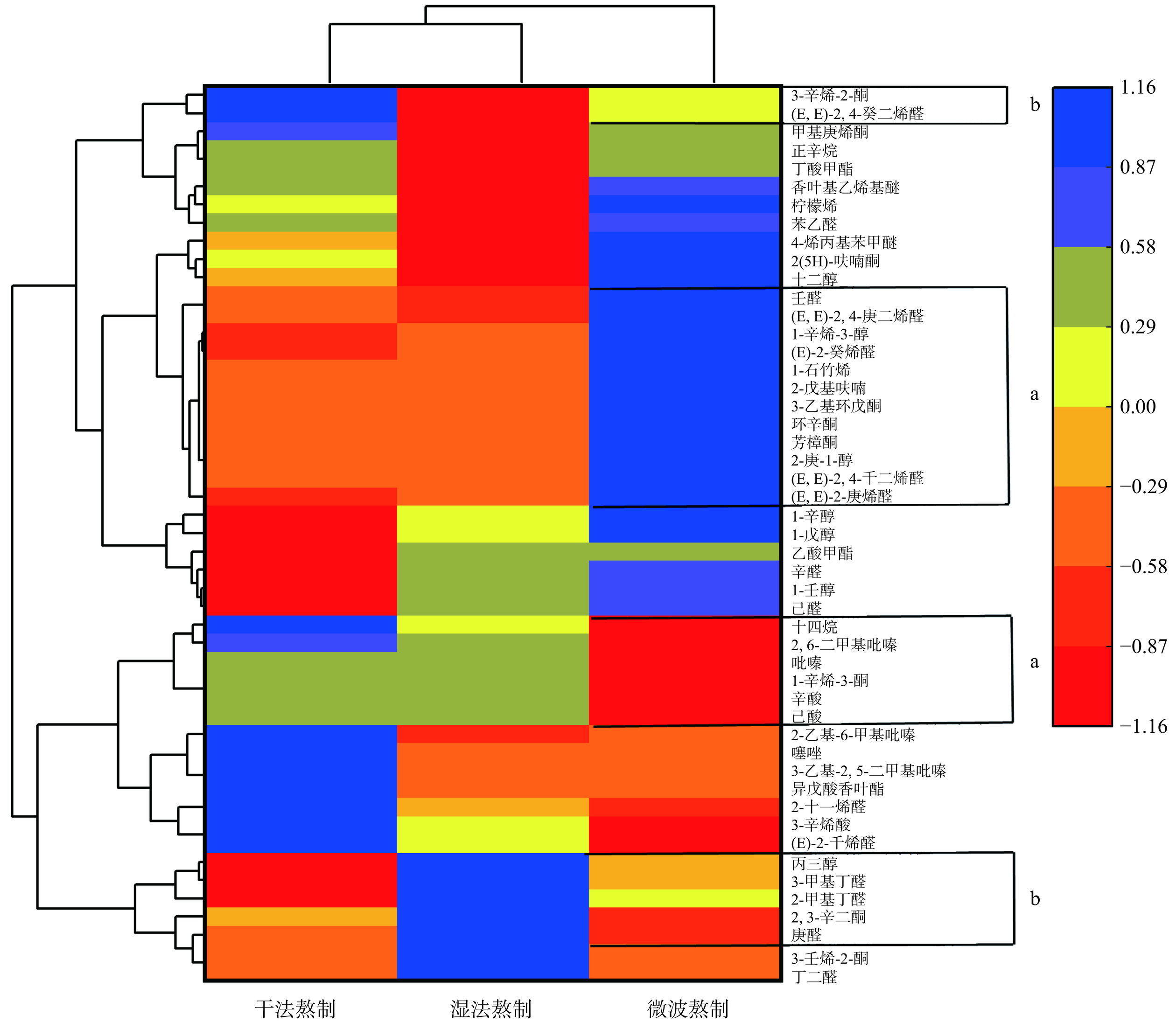Effects of Different Extraction Processes on the Physicochemical Properties and Volatile Flavor Compounds of Chicken Oil
-
摘要: 为了探究不同提取工艺对鸡油理化性质与挥发性风味物质的影响。本研究分别采用干法、湿法和微波熬制三种工艺提取鸡油,并对不同工艺提取鸡油的理化性质进行综合比较,同时采用顶空-气相色谱-质谱联用仪测定其挥发性风味物质构成,结合相对气味活度值、主成分分析和聚类分析明确不同提取工艺鸡油中的关键挥发性风味成分组成差异。结果表明,干法熬制的鸡油亮度最低,颜色更红、更黄,丙二醛含量较低;湿法熬制的鸡油亮度最高,颜色偏绿、偏黄,酸价较低;微波熬制的鸡油亮度稍暗,黄色和红色较浅,提取率较高,氧化稳定性较好且熬制时间短。不同提取工艺鸡油样品中共鉴定出49种挥发性风味物质,其中干法、湿法和微波法三种不同工艺所提取的鸡油中挥发性风味物质分别有39种、41种和44种,共有挥发性风味物质30种。结合ROAV和PCA,确定了(E,E)-2,4-庚二烯醛、1-辛烯-3-醇、己醛、(E)-2-癸烯醛、1-戊醇、辛醛、(E,E)-2,4-癸二烯醛、3-甲基丁醛为鸡油的主要特征风味物质。微波法提取鸡油的特征性风味物质含量较高且种类较多。本研究表明微波工艺相对而言具有耗时短、得率高、氧化稳定好以及鸡油特征性风味物质含量较高且种类多等优点,是一种值得深入研究与探索的鸡油提取工艺。Abstract: To investigate the effects of different extraction processes on the physicochemical properties and volatile flavor compounds of chicken oil. This study used three different extraction processes, namely dry, wet and microwave to extract chicken oil. The physicochemical properties of chicken oil extracted by different processes were comprehensively compared. At the same time, the volatile substance composition was determined by headspace gas chromatography-mass spectrometry, and the key volatile flavor component composition differences in chicken oil extracted by different processes were established by combining relative odor activity values, principal component analysis, and cluster analysis. The results showed that the chicken oil cooked by dry method had the lowest brightness, a redder and yellower color, and a lower content of malondialdehyde. Wet cooking chicken oil had the highest brightness, a greenish or yellowish color, and a lower acid value. The chicken oil cooked by microwave had a slightly darker brightness, lighter yellow and red, higher extraction rate, better oxidation stability, and shorter cooking time. A total of 49 volatile flavor compounds were identified in chicken oil samples extracted using different extraction methods. Among them, 39, 41, and 44 volatile flavor compounds were extracted from chicken oil using dry, wet, and microwave methods, respectively, with a total of 30 volatile flavor compounds. By combining ROAV and PCA, (E,E)-2,4-heptadienal, 1-octen-3-ol, hexanal, (E)-2-deceenal, 1-pentanol, octanal, (E,E)-2,4-decadienal, and 3-methylbutanal were identified as the main characteristic flavor compounds of chicken oil. The characteristic flavor substances extracted from chicken oil by microwave method had a high content and a variety of types. This study indicated that microwave technology had the advantages of relatively short time consumption, high yield, good oxidation stability and high content with variety of characteristic flavor substances in chicken oil, making it a worthwhile approach for further research and exploration of chicken oil extraction.
-
鸡油是鸡体内全部油脂类物质的总称[1],主要提取部位有鸡腹脂、鸡皮、鸡肉以及内脏。鸡油含有脂肪酸、维生素、磷脂、胆固醇、蛋白质[2]等成分。其中脂肪酸是鸡油的主要化学成分,也是影响鸡油风味的主要成分之一。鸡油富含人类生长发育所必需的营养物质。与其它富含饱和脂肪酸的动物脂肪不同,精制鸡油不饱和脂肪酸含量可高达88.07%[3−5],远高于牛、羊、猪等其他动物油脂。有研究表明,不饱和脂肪酸成分可以减少血液的粘稠程度,促进血液的微循环,可以提高大脑神经细胞的活力,对于改善记忆功能和增强思维能力也有着积极的功效[6−7]。鸡油色泽浅黄透明,具有浓郁的脂香味,常在烹调中起到增香调色的作用[8],在工业生产中可作为其它产品的重要原料[9−10],如通过鸡油进行醇解获得脂肪酸酯来进行生物柴油的制备[11−13]。精炼的鸡油经急冷捏合可以制造起酥油产品[14]。鸡油还可用来制备改善食品风味的肉味香精[15−16],因此近年来关于鸡油的提取工艺以及产品开发越来越受到重视。
在食品工业中,最常用的提取方法主要包括湿法熬制和干法熬制两种,两者之间最大的区别在于湿法熬制有水或者水蒸气的添加,而干法熬制则没有[17]。两种熬制工艺均有一定的优缺点。湿法熬制得到的产品氧化稳定性较好,但设备投资较大、耗时较长,一般应用于大型动物油脂厂。而干法熬制工艺技术比较简单,耗时也较短,比较适用于中小型加工厂,但得到的油脂酸价和过氧化值偏高[18]。随着鸡油现代提取工艺的发展,许多技术应用于鸡油提取,如微波熬制、水酶法、超临界流体萃取技术等。其中微波法因其提取时间短、提取率高、脂香味浓郁、氧化稳定性好等优点引起了有关学者的广泛关注,并做了一定研究。微波提取利用分子运动的相互摩擦效应,将微波场的场能转化为介质内的热能,从而产生热能和膨化等一系列物化过程来达到加热的目的。殷比等[19]利用微波法的特性提取鸡油,得到最佳提取工艺条件:功率密度为2.7325 W/g,提取时间 11.3 min,此条件下鸡油得率为84.279%。Sheu等[20]比较了微波熬炼、水煮、深油煎炸、传统烤制对鸡皮中油脂品质的影响,结果表明微波法提取率更高,时间短,对于油脂提取非常有意义。
我国黄羽肉鸡生产规模庞大,据农业农村部统计,2022年黄羽肉鸡累计出栏37.2亿只,据估计,每只肉鸡中约含有50~60 g鸡板油,即每年约有19~23万吨鸡板油产生,产量相当可观。如果处理不当以及提取不完全,不仅会造成资源浪费还会对环境造成污染,并且从传统肉鸡的烹饪和饮食习惯看,黄羽肉鸡更适合中国人的口味[21],因此本研究选择黄羽肉鸡板油作为提取原料。
目前,我国对鸡油的加工研究主要集中在油脂提取率提升和抗氧化剂对油脂品质的影响上[22]。不同提取方式对鸡油的理化性质与风味影响研究相对较少。理化性质与风味是判断鸡油的品质及质量优劣的重要指标,通过理化性质研究可以判别油脂的酸败程度是否在国家标准范围之内,同时理化性质也是油脂质量分级的一个重要标准[23−25]。气味是鸡油风味的典型特征之一,油脂挥发性物质是其气味产生的基础物质,其形成与制备工艺有着密切关联。因此本文旨在通过测定不同制取工艺所得鸡油样品的酸值、过氧化值、得率、水分等理化指标,以及结合相对气味活度值(relative odor activity value,ROAV)、主成分分析(principal component analysis,PCA)和聚类热图,对不同提取工艺鸡油样品的理化与风味品质进行分析,比较不同提取工艺鸡油的理化性质差异,确定鸡油的关键香气成分,并探索基于挥发性物质对不同工艺鸡油进行有效区分的可行性,以期为鸡油生产加工及品质控制提供理论依据。
1. 材料与方法
1.1 材料与仪器
黄羽鸡板油 江苏立华食品有限公司;氯仿、甲醇、氢氧化钾、无水乙醇、正己烷、可溶性淀粉、酚酞、硫代硫酸钠、碘化钾、氯化钠 分析纯,国药集团化学试剂有限公司。
PTX-FA210S电子天平 福州华志科学仪器;HTP-312电子天平 上海花潮实业有限公司;HH-4数显恒温水浴锅 常州国华电器有限公司;SCIENTZ-IID离心机 德国艾本股份公司;TG16-WS台式高速离心机 湖南湘仪实验室仪器开发有限公司;CR-400色差计 日本美能达仪器;XW-80A微型漩涡混合仪 上海沪西分析仪器有限公司;Gen5全波长酶标仪 美国伯腾仪器有限公司;Direct-Q3uv超纯水机 美国Millipore公司;7890b-5977型GC-MS联用仪、DB-WAX色谱柱(30 m×0.25 mm,0.25 µm) 美国安捷伦科技有限公司;GI100T高压灭菌锅 厦门致微仪器有限公司;PG23E0W美的微波 广东美的集团有限公司;JR05-300搅拌机 浙江苏泊尔股份有限公司。
1.2 实验方法
1.2.1 样品前处理
鸡板油经过搅拌机捣碎后,密封,于−18 ℃保存。
1.2.2 湿法熬制鸡油
鸡板油与水以1:1.5混合置于1000 mL烧杯中。在0.11 MPa的压力锅中蒸煮1 h,以20℃、5000 r/min离心5 min后经Φ20 cm、120目的不锈钢检验筛过滤得到鸡油[26]。
1.2.3 干法熬制鸡油
将一定质量的鸡板油置于坩埚碗内,在1000 W电炉上加热45 min,以20℃、5000 r/min离心5 min后经Φ20 cm、120目的不锈钢检验筛过滤得到鸡油[26]。
1.2.4 微波熬制鸡油
参考殷比[27]的方法并进行改进,将一定质量鸡板油放置在凹形瓷盘(可微波加热)内,置于微波炉中,微波功率密度为6 W/g,加热15 min,以20℃、5000 r/min离心5 min后经Φ20 cm、120目的不锈钢检验筛过滤得到鸡油。
1.2.5 油脂理化性质测定
1.2.5.1 酸价(AV)的测定
按照国标GB/T 5009.37-2003《食用植物油卫生标准的分析方法》热乙醇滴定法进行测定。
1.2.5.2 丙二醛(TBA)的测定
按照国标GB/T 5009.181-2016《食品安全国家标准 食品中丙二醛的测定》分光光度法进行测定。
1.2.5.3 过氧化值(POV)的测定
按照国标GB/T 5009.37-2003《食用植物油卫生标准的分析方法》滴定法进行测定。
1.2.5.4 水分含量测定
按照国标GB/T 26626-2011《动植物油脂 水分含量测定》电热干燥箱法进行测定。
1.2.5.5 色差测定
以色差计所设定的标准系统为对照,测定鸡油的亮度值(L*)、红绿值(a*)、黄蓝值(b*)。
1.2.6 气质联用色谱GC-MS分析
参照文献[28−30]修改如下。顶空条件:加热箱80 ℃,时间30 min;进样时间30 s,进样量1 µL;传输线温度100 ℃;定量环温度105 ℃。GC条件:40 ℃保持2 min后,以2 ℃/min速度升至45 ℃,再以3 ℃/min升至120 ℃保持2 min,再以6 ℃/min速度升温至230 ℃,保持6 min。进样口温度为250 ℃,载气为He,流速1 mL/min,不分流进样。MS条件:电子电离源;接口温度250 ℃;离子源温度230 ℃;电子能量70 eV;质量扫描范围30~550 m/z。化合物识别:化合物经过NIST谱库检索定性分析,仅报道匹配度大于80%的化合物,同时以各化合物峰面积占总峰面积的比值表示化合物的相对含量。
1.2.7 ROAV计算
通过计算ROAV,确定挥发性物质对样品风味的贡献[31]。一般认为ROAV>1的挥发性物质是样品中的关键风味物质,0.1<ROAV≤1的挥发性物质是对样品的总体风味起修饰作用[32]。选取化合物中对样品风味贡献最大的ROAVstan为100,其余各组分的ROAV按下计算:
ROAVA=CATA×TstanCstan×100 (1) 式中:CA为各组分的相对含量(%);TA为各组分的感觉阈值(mg/kg);Cstan为对整体风味贡献最大的化合物的相对含量(%);Tstan为对整体风味贡献最大的化合物的感觉阈值(mg/kg)。
1.2.8 鸡油得率计算
鸡油得率计算公式如下:
Y(%)=M0−M1M2×100 (2) 式中:Y为鸡油得率(%);M0为鸡油质量(g);M1水分质量(g);M2鸡板油质量(g)。
1.3 数据处理
所有实验平行3次,结果以平均值±标准差形式展现,采用Excel 2017进行数据统计整理。使用SPSS 26.0进行单因素方差(ANOVA)分析,其中P<0.05表示差异显著。采用Origin 2022软件进行主成分与聚类分析并绘图。
2. 结果与分析
2.1 不同提取工艺对鸡油理化品质的影响
通过研究不同工艺提取鸡油的丙二醛、酸价、过氧化值、水分、得率,比较不同提取工艺对鸡油理化品质的影响,结果如表1和表2所示。
表 1 不同提取工艺鸡油的理化性质Table 1. Physicochemical properties of chicken oil extracted by different Processes提取方法 丙二醛
(mg/kg)酸价
(mg/g)过氧化值
(meq/kg)水分(%) 得率(%) 干法熬制 0.67±0.03b 1.26±0.01a 2.77±0.11a 0.17±0.01b 74.34±0.03b 湿法熬制 0.73±0.03a 0.89±0.07b 2.56±0.02b 0.24±0.01a 69.94±0.14c 微波熬制 0.72±0.02a 1.01±0.08b 2.25±0.05c 0.15±0.01b 82.05±0.53a 注:同列右肩不同小写字母不同表示具有显著性差异(P<0.05);表2同。 表 2 不同提取工艺鸡油的色泽Table 2. Color of chicken oil by different extraction processes提取方法 L* a* b* 湿法熬制 44.67±0.40a −7.43±0.06c 38.74±0.02a 干法熬制 38.82±0.14c 3.31±0.10a 36.03±0.01b 微波熬制 40.90±0.13b 0.68±0.10b 29.29±0.05c 由表1可知湿法熬制、干法熬制、微波熬制3种方法对鸡油的丙二醛、酸价、水分、得率以及过氧化值的影响差异显著(P<0.05),经微波法熬制的鸡油过氧化值最低,丙二醛含量以及酸价介于干法熬制与湿法熬制之间,这可能是因为湿法熬制是鸡板油与水混合,鸡油中的游离脂肪酸以及氧化产生的脂肪酸可溶解于水中,使得鸡油游离脂肪酸含量较少,并且微波熬制过程中以较短的时间升高温度,短时间内油脂受到强烈的水分以及热量影响,发生水解使得酸价升高。微波法熬制的鸡油时间较短且温度较低,因此不容易造成鸡油的氧化反应[33]。微波熬制的鸡油得率最高,达到82.05%。这可能是由于在高速高频变化的电磁作用下,分子之间剧烈摩擦,产生热能,使得鸡板油的脂肪组织破坏程度最大,使得鸡油渗出最多,提取率最高。湿法熬制所得鸡油水分含量与干法熬制及微波熬制所得鸡油水分含量差异显著(P<0.05)这主要是因为湿法熬制是鸡板油与水混合并且熬制过程中不断产生水蒸气,使得鸡油中水分含量最多。
由表2和图1得到的结果来看,微波熬制的鸡油亮度稍暗,黄色和红色较浅。湿法熬制的鸡油亮度最高,比微波熬制和干法熬制更加偏绿、偏黄。干法熬制的鸡油亮度最低,比微波熬制的鸡油,颜色更红、更黄。这可能是干法熬制过程温度过高破坏了鸡油中的色素。
综合表1可知,三种提取方法中微波法提取的鸡油得率最高,过氧化值最低,并且所需时间为15 min,相比1 h的湿法熬制和45 min的干法熬制,极大程度上节约了时间成本,并且条件相对温和。虽然微波熬制鸡油的酸价高于湿法,但仍在国家标准范围之内。并且通过进一步精炼处理,可以使得鸡油酸价降低。
2.2 不同提取工艺鸡油的挥发性化合物GC-MS检测结果
如表3所示,不同提取工艺鸡油中共检测到49种挥发性物质,包括15种醛类、8种酮类、5种杂环类、8种醇类、3种酯类、3种酸类、4种烃类、3种其他化合物。其中湿法熬制的鸡油测得挥发性物质41种,湿法熬制的鸡油测得39种挥发性物质,微波熬制的鸡油测得挥发性物质44种,所有样品共有化合物有30种。鸡油样品中醛类占比最高,醛类物质中,相对含量最高的为己醛(18.46%~21.18%),其次为壬醛(10.49%~11.75%)和(E,E)-2,4-癸二烯醛(4.41%~6.53%)。醛类物质主要来自于脂质分子的自由基的裂解。脂质自动氧化生成的过氧化物在超过150 ℃时易分解,生成烷氧基自由基和羟自由基,烷氧基自由基进一步裂解形成挥发性的醛、烯和醇等有机化合物。其中(E,E)-2,4-癸二烯醛气味阈值较低,具有浓郁的脂香味,可以增强食物的鲜味[34]。
表 3 不同提取工艺鸡油的挥发性化合物的GC-MS检测结果Table 3. GC-MS detection results of volatile substances in chicken oil by different extraction processes编号 挥发性化合物 保留时间(min) 相对含量(%) 湿法 干法 微波 醛类 1 丁二醛 2.69 − 1.50±0.01 − 2 2-甲基丁醛 0.09 − 1.00±0.00a 0.94±0.01b 3 3-甲基丁醛 1.46 3.68±0.01c 5.48±0.01a 5.01±0.01b 4 己醛 5.32 18.46±0.08c 20.91±0.09b 21.18±0.01a 5 庚醛 7.84 2.01±0.01b 2.61±0.01a 1.94±0.01c 6 (E)-2-庚烯醛 10.62 2.06±0.01c 2.17±0.02b 2.65±0.01a 7 (E,E)-2,4-壬二烯醛 11.92 − − 3.38±0.01 8 (E,E)-2,4-庚二烯醛 12.89 1.32±0.01b 1.14±0.01c 2.02±0.01a 9 苯甲醛 14.07 3.12±0.09b − 3.6±0.01a 10 辛醛 15.12 1.77±0.01c 2.02±0.01b 2.14±0.04a 11 壬醛 16.3 10.49±0.06b 10.16±0.01c 11.75±0.01a 12 (E)-2-壬烯醛 18.48 0.59±0.01a 0.40±0.01b 0.21±0.01c 13 (E)-2-癸烯醛 22.23 0.15±0.01c 0.27±0.01b 2.64±0.00a 14 (E,E)-2,4-癸二烯醛 23.4 6.53±0.06a 4.41±0.01c 5.68±0.15b 15 2-十一烯醛 25.83 1.92±0.01c 1.48±0.02b 1.27±0.01a 醇类 16 1-戊醇 2.39 0.12±0.01c 0.15±0.01b 0.17±0.01a 17 1-辛烯-3-醇 2.6 0.40±0.01c 0.42±0.01b 0.53±0.01a 18 1-辛醇 5.65 0.39±0.01b 0.41±0.01b 0.47±0.01a 19 2-庚-1-醇 10.9 0.02±0.01b 0.06±0.06b 0.15±0.01a 20 1-壬醇 11.49 0.86±0.01b 1.01±0.00a 1.02±0.01a 21 十二醇 13.27 0.34±0.01b 0.31±0.01c 0.37±0.01a 22 芳樟醇 13.89 − − 0.01±0.00 23 丙三醇 15.78 4.12±0.05c 4.78±0.01a 4.47±0.01b 酯类 24 乙酸甲酯 4.62 0.02±0.01a 0.02±0.01a 0.02±0.01a 25 丁酸甲酯 11.89 0.03±0.01a 0.02±0.01a 0.03±0.01a 26 异戊酸香叶酯 27.14 0.02±0.01a 0.02±0.01a 0.02±0.00a 酸类 27 己酸 7.9 0.02±0.01a 0.02±0.01a 0.02±0.00a 28 辛酸 16.69 0.02±0.00a 0.02±0.01a 0.04±0.01a 29 3-辛烯酸 20.11 0.02±0.00a 0.01±0.00a − 酮类 30 1-辛烯-3-酮 2.98 0.71±0.01a 0.71±0.01a 0.65±0.01a 31 环辛酮 8.46 − 0.02±0.03b 0.08±0.01a 32 甲基庚烯酮 11.21 0.28±0.00a − 0.26±0.01b 33 2,3-辛二酮 18.96 1.10±0.01a 1.14±0.03a 1.06±0.01b 34 3-辛烯-2-酮 24.61 0.16±0.01a 0.11±0.01c 0.14±0.00b 35 2(5H)-呋喃酮 27.92 0.11±0.00a 0.08±0.01a 0.14±0.01a 36 3-乙基环戊酮 30.03 − − 0.08±0.01 37 3-壬烯-2-酮 12.24 − 0.07±0.00a − 杂环类 38 吡嗪 19.87 0.34±0.00a 0.34±0.00a 0.33±0.00a 39 2-戊基呋喃 23.84 − − 0.32±0.01a 40 2,6-二甲基吡嗪 24.44 0.33±0.00a 0.30±0.00b 0.21±0.01c 41 2-乙基-6-甲基吡嗪 24.76 0.32±0.01a 0.25±0.01b 0.26±0.01b 42 3-乙基-2,5-二甲基吡嗪 24.9 0.42±0.00 − − 烃类 43 柠檬烯 9.13 0.02±0.01b 0.02±0.01b 0.04±0.00a 44 1-石竹烯 9.42 − − 0.01±0.01a 45 正辛烷 9.55 0.02±0.00a 0.01±0.00a 0.02±0.00a 46 十四烷 10.21 0.87±0.01a 0.86±0.01b 0.85±0.00b 其它类 47 4-烯丙基苯甲醚 18.32 0.03±0.01ab 0.02±0.01b 0.05±0.01a 48 香叶基乙烯基醚 26.57 0.05±0.01b 0.03±0.00c 0.07±0.01a 49 噻唑 9.79 0.02±0.00 − − 注:同一行右肩小写字母不同表示具有显著性差异(P<0.05)。 2.3 不同提取工艺鸡油的关键香气成分分析
鸡油的总体风味是由挥发性物质的相对含量和感觉阈值共同决定的[35]。样品的关键风味物质是指对鸡油总体风味起到显著贡献作用的化合物。研究的样品包含几十种甚至上百种挥发性物质,气味活度值绝对定量成本高昂且繁琐,因此采用ROAV进行分析各挥发性物质对鸡油风味的贡献程度。
根据文献[36−37]查阅的阈值计算得到鸡油的风味物质ROAV值。如表4所示,筛选出ROAV值大于0.1的挥发性化合物,其中(E,E)-2,4-癸二烯醛是鸡油中风味贡献最大的物质。湿法熬制的鸡油中,3-甲基丁醛、己醛、苯甲醛、壬醛、(E)-2-壬烯醛、(E,E)-2,4-癸二烯醛 、1-戊醇、1-辛烯-3-醇、1-辛烯-3-酮是关键香气成分。干法熬制的鸡油中,3-甲基丁醛、己醛、壬醛、(E)-2-壬烯醛、(E,E)-2,4-癸二烯醛、1-戊醇、1-辛烯-3-醇、1-辛烯-3-酮是关键香气成分。微波熬制的鸡油中,(E,E)-2,4-癸二烯醛、3-甲基丁醛、苯甲醛、1-辛烯-3-醇、壬醛、1-辛烯-3-酮、1-戊醇、己醛、(E)-2-癸烯醛、(E)-2-壬烯醛、2,6-二甲基吡嗪是关键香气成分,其余化合物对鸡油的风味起修饰作用。其中共有的关键挥发性风味物质为3-甲基丁醛(水果香气)、己醛(青草气息)、壬醛(油脂气息)、(E)-2-壬烯醛(油脂气息)、(E,E)-2,4-癸二烯醛(油脂、鸡汤气息)、1-戊醇(辛辣味)、1-辛烯-3-醇(蘑菇气息)、1-辛烯-3-酮(蘑菇气息)。陈德慰等[38]利用顶空固相微萃取-气相色谱-质谱联用技术对鸡油挥发性风味化合物进行测定。共测出8种关键挥发性物质,分别为(E,E)-2,4-癸二烯醛、(E,E)-2,4-壬二烯醛、(E)-2-癸烯醛、(E)-2-壬烯醛、(E)-2-庚烯醛、己醛、1-辛烯-3-酮和1-辛烯-3-醇与本研究结果基本相似。
表 4 不同提取工艺鸡油的挥发性物质ROAV值Table 4. ROAV values of flavor substances in chicken oil by different extraction processes风味物质 湿法熬制 干法熬制 微波熬制 3-甲基丁醛 45.78 108.42 54.96 己醛 1.00 1.80 1.01 (E,E)-2,4-庚二烯醛 0.28 0.40 0.39 苯甲醛 15.75 0.00 16.46 辛醛 0.13 0.24 0.14 壬醛 4.19 6.48 4.17 (E)-2-壬烯醛 9.36 10.19 3.11 (E)-2-癸烯醛 0.12 0.33 1.70 (E,E)-2,4-癸二烯醛 116.43 124.10 90.76 2-十一烯醛 0.54 0.66 0.32 1-戊醇 1.39 3.00 1.86 1-辛烯-3-醇 5.00 8.07 5.82 1-辛醇 0.26 0.47 0.29 1-壬醇 0.22 0.40 0.23 1-辛烯-3-酮 4.33 6.88 3.66 吡嗪 0.89 0.92 0.96 2,6-二甲基吡嗪 0.78 0.98 1.03 2.4 不同提取工艺鸡油的关键香气成分PCA
PCA是采用降维的方式,找出对样品贡献最大的因子,利用PCA分布图可以最大程度上体现因子的差异性。对表4中17中风味物质进行PCA分析,如图2所示,共提取到2个PC,PC1和PC2累计方差贡献率为85.1%,可以较好地反映原始数据的绝大部分信息,符合PCA要求。
![]() 图 2 不同提取工艺鸡油的挥发性风味物质PCA载荷图注:1~17分别为3-甲基丁醛(1)、己醛(2)、(E,E)-2,4-庚二烯醛(3)、苯甲醛(4)、辛醛(5)、壬醛(6)、(E)-2-壬烯醛(7)、(E)-2-癸烯醛(8)、(E,E)-2,4-癸二烯醛(9)、2-十一烯醛(10)、1-戊醇(11)、1-辛烯-3-醇(12)、1-辛醇(13)、1-壬醇(14)、1-辛烯-3-酮(15)、吡嗪(16)、2,6-二甲基吡嗪(17)。Figure 2. PCA loading diagram of volatile flavor substances in chicken oil with different extraction processes
图 2 不同提取工艺鸡油的挥发性风味物质PCA载荷图注:1~17分别为3-甲基丁醛(1)、己醛(2)、(E,E)-2,4-庚二烯醛(3)、苯甲醛(4)、辛醛(5)、壬醛(6)、(E)-2-壬烯醛(7)、(E)-2-癸烯醛(8)、(E,E)-2,4-癸二烯醛(9)、2-十一烯醛(10)、1-戊醇(11)、1-辛烯-3-醇(12)、1-辛醇(13)、1-壬醇(14)、1-辛烯-3-酮(15)、吡嗪(16)、2,6-二甲基吡嗪(17)。Figure 2. PCA loading diagram of volatile flavor substances in chicken oil with different extraction processes图2结果表明己醛(2)、1-辛烯-3-醇(12)、(E)-2-癸烯醛(8)、(E,E)-2,4-庚二烯醛(3)、1-戊醇(11)、辛醛(5)、3-甲基丁醛(1)与PC1显示较强的正相关,(E)-2-壬烯醛(7)、2-十一烯醛(10)、2,6-二甲基吡嗪(17)与PC1显示较强的负相关。苯甲醛(4)、(E,E)-2,4-癸二烯醛(9)与PC2显示较强的正相关,1-辛醇(13)、1-壬醇(14)、3-甲基丁醛(1)、1-辛烯-3-酮(15)、2,6-二甲基吡嗪(17)与PC2显示较强的负相关。结合ROAV值分析可得(E,E)-2,4-庚二烯醛(3)、己醛(2)、1-辛烯-3-醇(12)、(E)-2-癸烯醛(8)、1-戊醇(11)、辛醛(5)、(E,E)-2,4-癸二烯醛(9)、3-甲基丁醛(1)为鸡油的关键香气成分。图3结果可以明显区分不同提制工艺鸡油样品。湿法熬制、干法熬制、微波熬制的鸡油样品距离较远,说明3种不同提取工艺的鸡油风味具有明显差异,即可以通过挥发性化合物将3种不同提取方法所得的鸡油进行区分开。
2.5 不同提取工艺鸡油挥发性成分的聚类分析
图4中每种物质的平均值的差值大小用不同颜色的深浅程度表示,颜色越深含量越高,颜色越浅含量越低。最深色为不同样品间特有成分。如图4所示,微波熬制与干法熬制和湿法熬制所得的鸡油样品挥发性成分含量颜色差异明显。可以根据a和b区域的挥发性物质将所有样品分为两大类,一类是微波法熬制鸡油,另一类是干法熬制和湿法熬制鸡油。a区域中微波法熬制所得鸡油挥发性物质含量均高于湿法熬制和干法熬制的样品。对于b区域中的挥发性物质,湿法和干法的样品均高于微波法的样品。对于其他区域挥发性物质,样品之间的挥发性物质含量并无规律变化,因此可通过a和b的挥发性物质含量对不同提取工艺鸡油进行区分。
3. 结论
经过对不同工艺所制取鸡油的酸价、过氧化值、得率等指标的测定,发现干法熬制、微波熬制3种方法对鸡油的得率以及过氧化值的影响差异显著,对丙二醛、酸值、水分影响差异较小。经微波法熬制的鸡油过氧化值最低,得率最高。微波熬制的鸡油亮度稍暗,黄色和红色较浅,品质优良且熬制时间短。通过GC-MS分析不同工艺制取鸡油的挥发性化合物,并结合ROAV和PCA确定鸡油中的关键香气成分,基于不同挥发性物质对不同提取工艺进行区分,结果表明三种不同提取工艺样品中共鉴定出49种挥发性物质,包括15种醛类、8种酮类、5种杂环类、8种醇类、3种酯类、3种酸类、4种烃类、3种其他化合物。结合ROAV和PCA,确定了(E,E)-2,4-庚二烯醛、己醛、1-辛烯-3-醇、(E)-2-癸烯醛、1-戊醇、辛醛、(E,E)-2,4-癸二烯醛、3-甲基丁醛为鸡油的主要特征风味物质。通过挥发性成分聚类热图分析,不同工艺制备的样品之间色差较大,表明挥发性物质可作为区分不同工艺制备鸡油的判别方式。理化性质与挥发性风味品质是判断鸡油的品质优劣的重要指标,通过理化性质研究可以判别油脂的酸败程度是否在国家标准之内,气味是鸡油风味的典型特征之一,油脂挥发性物质是其气味产生的基础物质,其形成与制备工艺有着密切关联,因此本研究通过测定不同提取工艺所得鸡油样品的理化指标,以及对不同提取工艺鸡油样品的理化与挥发性风味品质进行分析,比较出不同提取工艺鸡油的理化性质差异,确定鸡油的关键香气成分,并基于挥发性风味物质对不同工艺鸡油进行有效区分,为鸡油生产加工及品质控制提供了理论依据和技术支撑。
-
图 2 不同提取工艺鸡油的挥发性风味物质PCA载荷图
注:1~17分别为3-甲基丁醛(1)、己醛(2)、(E,E)-2,4-庚二烯醛(3)、苯甲醛(4)、辛醛(5)、壬醛(6)、(E)-2-壬烯醛(7)、(E)-2-癸烯醛(8)、(E,E)-2,4-癸二烯醛(9)、2-十一烯醛(10)、1-戊醇(11)、1-辛烯-3-醇(12)、1-辛醇(13)、1-壬醇(14)、1-辛烯-3-酮(15)、吡嗪(16)、2,6-二甲基吡嗪(17)。
Figure 2. PCA loading diagram of volatile flavor substances in chicken oil with different extraction processes
表 1 不同提取工艺鸡油的理化性质
Table 1 Physicochemical properties of chicken oil extracted by different Processes
提取方法 丙二醛
(mg/kg)酸价
(mg/g)过氧化值
(meq/kg)水分(%) 得率(%) 干法熬制 0.67±0.03b 1.26±0.01a 2.77±0.11a 0.17±0.01b 74.34±0.03b 湿法熬制 0.73±0.03a 0.89±0.07b 2.56±0.02b 0.24±0.01a 69.94±0.14c 微波熬制 0.72±0.02a 1.01±0.08b 2.25±0.05c 0.15±0.01b 82.05±0.53a 注:同列右肩不同小写字母不同表示具有显著性差异(P<0.05);表2同。 表 2 不同提取工艺鸡油的色泽
Table 2 Color of chicken oil by different extraction processes
提取方法 L* a* b* 湿法熬制 44.67±0.40a −7.43±0.06c 38.74±0.02a 干法熬制 38.82±0.14c 3.31±0.10a 36.03±0.01b 微波熬制 40.90±0.13b 0.68±0.10b 29.29±0.05c 表 3 不同提取工艺鸡油的挥发性化合物的GC-MS检测结果
Table 3 GC-MS detection results of volatile substances in chicken oil by different extraction processes
编号 挥发性化合物 保留时间(min) 相对含量(%) 湿法 干法 微波 醛类 1 丁二醛 2.69 − 1.50±0.01 − 2 2-甲基丁醛 0.09 − 1.00±0.00a 0.94±0.01b 3 3-甲基丁醛 1.46 3.68±0.01c 5.48±0.01a 5.01±0.01b 4 己醛 5.32 18.46±0.08c 20.91±0.09b 21.18±0.01a 5 庚醛 7.84 2.01±0.01b 2.61±0.01a 1.94±0.01c 6 (E)-2-庚烯醛 10.62 2.06±0.01c 2.17±0.02b 2.65±0.01a 7 (E,E)-2,4-壬二烯醛 11.92 − − 3.38±0.01 8 (E,E)-2,4-庚二烯醛 12.89 1.32±0.01b 1.14±0.01c 2.02±0.01a 9 苯甲醛 14.07 3.12±0.09b − 3.6±0.01a 10 辛醛 15.12 1.77±0.01c 2.02±0.01b 2.14±0.04a 11 壬醛 16.3 10.49±0.06b 10.16±0.01c 11.75±0.01a 12 (E)-2-壬烯醛 18.48 0.59±0.01a 0.40±0.01b 0.21±0.01c 13 (E)-2-癸烯醛 22.23 0.15±0.01c 0.27±0.01b 2.64±0.00a 14 (E,E)-2,4-癸二烯醛 23.4 6.53±0.06a 4.41±0.01c 5.68±0.15b 15 2-十一烯醛 25.83 1.92±0.01c 1.48±0.02b 1.27±0.01a 醇类 16 1-戊醇 2.39 0.12±0.01c 0.15±0.01b 0.17±0.01a 17 1-辛烯-3-醇 2.6 0.40±0.01c 0.42±0.01b 0.53±0.01a 18 1-辛醇 5.65 0.39±0.01b 0.41±0.01b 0.47±0.01a 19 2-庚-1-醇 10.9 0.02±0.01b 0.06±0.06b 0.15±0.01a 20 1-壬醇 11.49 0.86±0.01b 1.01±0.00a 1.02±0.01a 21 十二醇 13.27 0.34±0.01b 0.31±0.01c 0.37±0.01a 22 芳樟醇 13.89 − − 0.01±0.00 23 丙三醇 15.78 4.12±0.05c 4.78±0.01a 4.47±0.01b 酯类 24 乙酸甲酯 4.62 0.02±0.01a 0.02±0.01a 0.02±0.01a 25 丁酸甲酯 11.89 0.03±0.01a 0.02±0.01a 0.03±0.01a 26 异戊酸香叶酯 27.14 0.02±0.01a 0.02±0.01a 0.02±0.00a 酸类 27 己酸 7.9 0.02±0.01a 0.02±0.01a 0.02±0.00a 28 辛酸 16.69 0.02±0.00a 0.02±0.01a 0.04±0.01a 29 3-辛烯酸 20.11 0.02±0.00a 0.01±0.00a − 酮类 30 1-辛烯-3-酮 2.98 0.71±0.01a 0.71±0.01a 0.65±0.01a 31 环辛酮 8.46 − 0.02±0.03b 0.08±0.01a 32 甲基庚烯酮 11.21 0.28±0.00a − 0.26±0.01b 33 2,3-辛二酮 18.96 1.10±0.01a 1.14±0.03a 1.06±0.01b 34 3-辛烯-2-酮 24.61 0.16±0.01a 0.11±0.01c 0.14±0.00b 35 2(5H)-呋喃酮 27.92 0.11±0.00a 0.08±0.01a 0.14±0.01a 36 3-乙基环戊酮 30.03 − − 0.08±0.01 37 3-壬烯-2-酮 12.24 − 0.07±0.00a − 杂环类 38 吡嗪 19.87 0.34±0.00a 0.34±0.00a 0.33±0.00a 39 2-戊基呋喃 23.84 − − 0.32±0.01a 40 2,6-二甲基吡嗪 24.44 0.33±0.00a 0.30±0.00b 0.21±0.01c 41 2-乙基-6-甲基吡嗪 24.76 0.32±0.01a 0.25±0.01b 0.26±0.01b 42 3-乙基-2,5-二甲基吡嗪 24.9 0.42±0.00 − − 烃类 43 柠檬烯 9.13 0.02±0.01b 0.02±0.01b 0.04±0.00a 44 1-石竹烯 9.42 − − 0.01±0.01a 45 正辛烷 9.55 0.02±0.00a 0.01±0.00a 0.02±0.00a 46 十四烷 10.21 0.87±0.01a 0.86±0.01b 0.85±0.00b 其它类 47 4-烯丙基苯甲醚 18.32 0.03±0.01ab 0.02±0.01b 0.05±0.01a 48 香叶基乙烯基醚 26.57 0.05±0.01b 0.03±0.00c 0.07±0.01a 49 噻唑 9.79 0.02±0.00 − − 注:同一行右肩小写字母不同表示具有显著性差异(P<0.05)。 表 4 不同提取工艺鸡油的挥发性物质ROAV值
Table 4 ROAV values of flavor substances in chicken oil by different extraction processes
风味物质 湿法熬制 干法熬制 微波熬制 3-甲基丁醛 45.78 108.42 54.96 己醛 1.00 1.80 1.01 (E,E)-2,4-庚二烯醛 0.28 0.40 0.39 苯甲醛 15.75 0.00 16.46 辛醛 0.13 0.24 0.14 壬醛 4.19 6.48 4.17 (E)-2-壬烯醛 9.36 10.19 3.11 (E)-2-癸烯醛 0.12 0.33 1.70 (E,E)-2,4-癸二烯醛 116.43 124.10 90.76 2-十一烯醛 0.54 0.66 0.32 1-戊醇 1.39 3.00 1.86 1-辛烯-3-醇 5.00 8.07 5.82 1-辛醇 0.26 0.47 0.29 1-壬醇 0.22 0.40 0.23 1-辛烯-3-酮 4.33 6.88 3.66 吡嗪 0.89 0.92 0.96 2,6-二甲基吡嗪 0.78 0.98 1.03 -
[1] 徐坤, 史翠平, 王宝维, 等. 高压静电处理加热对鸡油理化特性的影响[J]. 肉类研究,2018,32(5):15−18. [XU Kun, SHI Cuiping, WANG Baowei, et al. Effect of high-voltage electrostatic field treatment on physicochemical properties of chicken fat[J]. Meat Research,2018,32(5):15−18.] XU Kun, SHI Cuiping, WANG Baowei, et al. Effect of high-voltage electrostatic field treatment on physicochemical properties of chicken fat[J]. Meat Research, 2018, 32(5): 15−18.
[2] 薛淼, 何新益, 闫西纯. 调味辣椒鸡油制备工艺的研究[J]. 食品研究与开发,2019,40(2):120−124. [XUE Miao, HE Xinyi, YAN Xichun. Study on the preparation of chili chicken oil[J]. Food Research and Development,2019,40(2):120−124.] doi: 10.3969/j.issn.1005-6521.2019.02.023 XUE Miao, HE Xinyi, YAN Xichun. Study on the preparation of chili chicken oil[J]. Food Research and Development, 2019, 40(2): 120−124. doi: 10.3969/j.issn.1005-6521.2019.02.023
[3] 时秋娜, 刘占芳, 田菲菲. 不同动物油中脂肪酸成分的全二维气相色谱-质谱法检验[J]. 中国刑警学院学报,2017(4):84−87. [SHI Qiuna, LIU Zhanfang, TIAN Feifei. Full two-dimensional gas chromatography-mass spectrometry detection of fatty acid components in different animal oils[J]. Journal of China Criminal Police Academy,2017(4):84−87.] SHI Qiuna, LIU Zhanfang, TIAN Feifei. Full two-dimensional gas chromatography-mass spectrometry detection of fatty acid components in different animal oils[J]. Journal of China Criminal Police Academy, 2017(4): 84−87.
[4] 李向阳, 赵飞, 孙思远, 等. 鸡油的化学成分及制备工艺研究[J]. 粮油食品科技,2017,25(3):44−47. [LI Xiangyang, ZHAO Fei, SUN Siyuan, et al. Research on chemical composition and preparation technology of chicken oil[J]. Science and Technology of Cereals, Oils and Foods,2017,25(3):44−47.] LI Xiangyang, ZHAO Fei, SUN Siyuan, et al. Research on chemical composition and preparation technology of chicken oil[J]. Science and Technology of Cereals, Oils and Foods, 2017, 25(3): 44−47.
[5] 殷比, 芮汉明, 张立彦. 不同鸡种鸡板油脂肪中脂肪酸组分含量分析[J]. 食品工业科技,2011,32(5):126−128. [YIN Bi, RUI Hanming, ZHANG Liyan. Analysis of Fatty acid components in the fat of different chicken breed chicken slate[J]. Food Industry Technology,2011,32(5):126−128.] YIN Bi, RUI Hanming, ZHANG Liyan. Analysis of Fatty acid components in the fat of different chicken breed chicken slate[J]. Food Industry Technology, 2011, 32(5): 126−128.
[6] HWANG K N, TUNG H P, LU Y H, et al. Liquid chicken oil could be a healthy dietary oil[J]. Journal of Oleo Science,2021,70(8):1157−1164. doi: 10.5650/jos.ess21053
[7] SHRAMKO V S, RAGINO Y I, POLONSKAYA Y V, et al. Associations of unsaturated fatty acids with indicators of the antioxidant system in men with coronary atherosclerosis[J]. Atherosclerosis,2021,331:e208.
[8] 朱萌, 王军, 郭宇明, 等. 不同干燥方式对热反应鸡粉挥发性风味物质的影响[J]. 食品工业科技,2020,41(15):53−58. [ZHU Meng, WANG Jun, GUO Yuming, et al. Effects of different drying methods on various flavor compounds of heat reaction chicken powder[J]. Science and Technology of Food Industry,2020,41(15):53−58.] ZHU Meng, WANG Jun, GUO Yuming, et al. Effects of different drying methods on various flavor compounds of heat reaction chicken powder[J]. Science and Technology of Food Industry, 2020, 41(15): 53−58.
[9] 姚饶饶, 黄振徐, 赵培培. 鸡精加工工艺研究进展[J]. 现代食品,2021,27(13):43−45. [YAO Raorao, HUANG Zhenxu, ZHAO Peipei. Progresses of chicken essence machining research[J]. Modern Food,2021,27(13):43−45.] YAO Raorao, HUANG Zhenxu, ZHAO Peipei. Progresses of chicken essence machining research[J]. Modern Food, 2021, 27(13): 43−45.
[10] 陆君, 刘奕, 闫丹丹. 鸡精调味料鸡肉风味的优化[J]. 食品工业,2019,40(10):66−70. [LU Jun, LIU Yi, YAN Dandan. Optimization of chicken flavor in chicken seasoning[J]. The Food Industry,2019,40(10):66−70.] LU Jun, LIU Yi, YAN Dandan. Optimization of chicken flavor in chicken seasoning[J]. The Food Industry, 2019, 40(10): 66−70.
[11] KIRUBAKARAN M, ARUL M S V. Experimental investigation on the effects of micro eggshell and nano-eggshell catalysts on biodiesel optimization from waste chicken fat[J]. Bioresource Technology Reports,2021,14:100658. doi: 10.1016/j.biteb.2021.100658
[12] ODETOYE T E, AGU J O, AJALA E O. Biodiesel production from poultry wastes:Waste chicken fat and eggshell[J]. Journal of Environmental Chemical Engineering,2021,9(4):105654. doi: 10.1016/j.jece.2021.105654
[13] SANTOSO A, SALIM A, et al. Synthesis of methyl ester from chicken oil and methanol using heterogeneous catalyst of CaO-MgO as well as characterization its potential as a biodiesel fuel[J]. Journal of Physics, Conference series,2018,1093(1):12035.
[14] GHOSH S, BHATTACHARYYA D K. Utilization of high-melting palm stearin in lipase-catalyzed interesterification with liquid oils[J]. Journal of the American Oil Chemists Society,1997,74(5):589−592. doi: 10.1007/s11746-997-0185-y
[15] SUN A, WU W, SOLADOYE O P, et al. Maillard reaction of food-derived peptides as a potential route to generate meat flavor compounds:A review[J]. Food Research International,2022,151:1100823.
[16] KIRALAN S S, KARAGOZ S G, OZKAN G, et al. Changes in volatile compounds of virgin olive oil flavored with essential oils during thermal and photo-oxidation[J]. Food Analytical Methods,2021,14:883−896. doi: 10.1007/s12161-020-01926-w
[17] 潘金龙, 郑静, 王李平, 等. 禽类油脂研发现状与发展趋势[J]. 食品与发酵科技,2022,58(3):153−158. [PAN Jinlong, ZHENG Jing, WANG Liping, et al. Research status and development trend of poultry oil[J]. Sichuan Food and Fermentation,2022,58(3):153−158.] doi: 10.3969/j.issn.1674-506X.2022.03-021 PAN Jinlong, ZHENG Jing, WANG Liping, et al. Research status and development trend of poultry oil[J]. Sichuan Food and Fermentation, 2022, 58(3): 153−158. doi: 10.3969/j.issn.1674-506X.2022.03-021
[18] 欧秀琼, 钟正泽, 解华东, 等. 鸭油提取工艺研究[J]. 中国油脂,2020,45(9):8−11. [OU Xiuqiong, ZHONG Zhengze, XIE Huadong, et al. Study on the extraction process of duck oil[J]. Chinese Oil,2020,45(9):8−11.] OU Xiuqiong, ZHONG Zhengze, XIE Huadong, et al. Study on the extraction process of duck oil[J]. Chinese Oil, 2020, 45(9): 8−11.
[19] 殷比, 芮汉明, 张立彦. 微波熬炼制取鸡油的条件研究[J]. 现代食品科技,2010,26(11):1223−1228. [YIN Bi, RUI Hanming, ZHANG Liyan. Microwave extraction of chicken fat from chicken depot fat[J]. Modern Food Scince & Technology,2010,26(11):1223−1228.] YIN Bi, RUI Hanming, ZHANG Liyan. Microwave extraction of chicken fat from chicken depot fat[J]. Modern Food Scince & Technology, 2010, 26(11): 1223−1228.
[20] SHEU K S, CHEN T C. Yield and quality characteristics of edible broiler skin fat as obtained from five rendering methods[J]. Journal of food engineering,2002,55(3):263−269. doi: 10.1016/S0260-8774(02)00100-0
[21] 文杰. 中国肉鸡生产现状与展望[J]. 北方牧业,2022(17):18. [WEN Jie. The current situation and prospects of broiler production in China[J]. Northern Animal Husbandry,2022(17):18.] WEN Jie. The current situation and prospects of broiler production in China[J]. Northern Animal Husbandry, 2022(17): 18.
[22] 李鹏, 孙京新, 王宝维, 等. 干法分提鸡油的贮藏稳定性[J]. 肉类研究,2018,32(7):54−58. [LI Peng, SUN Jingxin, WANG Baowei, et al. Storage stability of dry extraction chicken oil[J]. Meat Research,2018,32(7):54−58.] LI Peng, SUN Jingxin, WANG Baowei, et al. Storage stability of dry extraction chicken oil[J]. Meat Research, 2018, 32(7): 54−58.
[23] 史亚静, 葛柳凤. 不同制作工艺对猪油理化与风味品质的影响[J]. 肉类研究,2020,34(4):40−45. [SHI Yajing, GE Liufeng. The effect of different production processes on the physicochemical and flavor quality of lard[J]. Meat Research,2020,34(4):40−45.] SHI Yajing, GE Liufeng. The effect of different production processes on the physicochemical and flavor quality of lard[J]. Meat Research, 2020, 34(4): 40−45.
[24] 黄玉坤, 田红媚, 陈芳, 等. 三种香型食用牛油的挥发性风味物质分析及鉴定[J]. 食品与发酵工业,2019,45(3):196−205. [HUANG Yukun, TIAN Hongmei, CHEN Fang, et al. Analysis and identification of volatile flavor compounds in three types of aromatic edible butter[J]. Food and Fermentation Industry,2019,45(3):196−205.] HUANG Yukun, TIAN Hongmei, CHEN Fang, et al. Analysis and identification of volatile flavor compounds in three types of aromatic edible butter[J]. Food and Fermentation Industry, 2019, 45(3): 196−205.
[25] 秦雅丽. 牛油关键风味物质的鉴定及可控美拉德反应法制备[D]. 无锡:江南大学, 2022. [QIN Yali. Identification preparation by Maillard method of key aroma compounds in tallow[D]. Wuxi:Jiangnan University, 2022.] QIN Yali. Identification preparation by Maillard method of key aroma compounds in tallow[D]. Wuxi: Jiangnan University, 2022.
[26] 柴向华, 陈春, 吴克刚. 微波法熬制鸡油工艺条件的研究[J]. 食品科技,2013,38(11):133−136. [CHAI Xianghua, CHEN Chun, WU Kegang. A Study on the technological conditions for cooking chicken oil by microwave method[J]. Food Technology,2013,38(11):133−136.] CHAI Xianghua, CHEN Chun, WU Kegang. A Study on the technological conditions for cooking chicken oil by microwave method[J]. Food Technology, 2013, 38(11): 133−136.
[27] 殷比. 纯鸡粉生产关键技术研究[D]. 广州:华南理工大学, 2011. [YIN Bi. Research on the key technologies of Chicken powder[D]. Guangzhou:South China University of Technology, 2011.] YIN Bi. Research on the key technologies of Chicken powder[D]. Guangzhou: South China University of Technology, 2011.
[28] 何小燕, 田洪磊, 詹萍, 等. 基于PCA模式不同处理方式鸡脂挥发性成分与化学指标相关性研究[J]. 中国油脂,2016,41(4):41−45. [HE Xiaoyan, TIAN Honglei, ZHAN Ping, et al. Correlation between volatile components and chemical indexes of chicken fat treated by different methods based on pca mode[J]. China Oils and Fats,2016,41(4):41−45.] doi: 10.3969/j.issn.1003-7969.2016.04.010 HE Xiaoyan, TIAN Honglei, ZHAN Ping, et al. Correlation between volatile components and chemical indexes of chicken fat treated by different methods based on pca mode[J]. China Oils and Fats, 2016, 41(4): 41−45. doi: 10.3969/j.issn.1003-7969.2016.04.010
[29] 韩小苗, 吴苏喜, 吴美芳, 等. 不同工艺制取的茶籽油挥发性风味成分分析[J]. 中国油脂,2018,43(1):39−42. [HAN Xiaomiao, WU Suxi, WU Meifang, et al. Detection of volatile flavor compounds in oil-tea camellia seed oils prepared by different processes[J]. China Oils and Fats,2018,43(1):39−42.] doi: 10.3969/j.issn.1003-7969.2018.01.011 HAN Xiaomiao, WU Suxi, WU Meifang, et al. Detection of volatile flavor compounds in oil-tea camellia seed oils prepared by different processes[J]. China Oils and Fats, 2018, 43(1): 39−42. doi: 10.3969/j.issn.1003-7969.2018.01.011
[30] 刘佳敏, 何新益, 刘晓东, 等. 精炼对牛油主要理化指标及挥发性成分的影响[J]. 食品与机械,2020,36(4):62−67. [LIU Jiamin, HE Xinyi, LIU Xiaodong, et al. The effect of refining on the main physicochemical indicators and volatile components of butter[J]. Food and Machinery,2020,36(4):62−67.] LIU Jiamin, HE Xinyi, LIU Xiaodong, et al. The effect of refining on the main physicochemical indicators and volatile components of butter[J]. Food and Machinery, 2020, 36(4): 62−67.
[31] YU M G, LI T, WAN S Y, et al. Sensory-directed establishment of sensory wheel and characterization of key aroma-active compounds for spicy tallow hot pot seasoning[J]. Food Chemistry,2023,405:134904. doi: 10.1016/j.foodchem.2022.134904
[32] JIA W, LI R T, WU X X, et al. UHPLC-Q-Orbitrap HRMS-based quantitative lipidomics reveals the chemical changes of phospholipids during thermal processing methods of Tan sheep meat[J]. Food Chemistry,2021,360:130153. doi: 10.1016/j.foodchem.2021.130153
[33] 温雪馨, 芮汉明. 微波工作站对油脂组分微波升温特性的研究[J]. 食品工业科技,2010(4):100−103. [WEN Xuexin, RUI Hanming. Study on the temperature-rising characteristics of oil with microwave workstation[J]. Science and Technology of Food Industry,2010(4):100−103.] WEN Xuexin, RUI Hanming. Study on the temperature-rising characteristics of oil with microwave workstation[J]. Science and Technology of Food Industry, 2010(4): 100−103.
[34] 吕晓玲, 杨雪吟, 李津, 等. 精制各阶段牛油风味研究[J]. 粮食与油脂,2011(11):24−27. [LÜ Xiaoling, YANG Xueyin, LI Jin, et al. A study on the flavor of refined butter at different stages[J]. Grain and Oil,2011(11):24−27.] doi: 10.3969/j.issn.1008-9578.2011.11.007 LÜ Xiaoling, YANG Xueyin, LI Jin, et al. A study on the flavor of refined butter at different stages[J]. Grain and Oil, 2011(11): 24−27. doi: 10.3969/j.issn.1008-9578.2011.11.007
[35] GARRIDO-DELGADO R, DOBAO-PRIETO M D M, ARCE L, et al. Determination of volatile compounds by GC–IMS to assign the quality of virgin olive oil[J]. Food Chemistry,2015,187:572−579. doi: 10.1016/j.foodchem.2015.04.082
[36] SCHIFFMAN S S, BENNETT J L, RAYMER J H. Quantification of odors and odorants from swine operations in North Carolina[J]. Agric Forest Meteorol,2001,108(3):213−240. doi: 10.1016/S0168-1923(01)00239-8
[37] LO YCM, KOZIEL J A, CAI L, et al. Simultaneous chemical and sensory characterization of volatile organic compounds and semi-volatile organic compounds emitted from swine manure using solid phase microextraction and multidimensional gas chromatography-mass spectrometry-olfactometry[J]. J Environ Qual,2008,37(2):521−534. doi: 10.2134/jeq2006.0382
[38] 陈德慰, 杨晓莹, 刘思佚, 等. 鸡油组织中的磷脂对鸡油挥发性风味化合物形成的影响[J]. 农业工程学报,2020,36(23):279−284. [CHEN Dewei, YANG Xiaoying, LIU Siyi, et al. Effect of phospholipids on the formation of volatile flavor compounds in chicken fat[J]. Transactions of the Chinese Society of Agricultural Engineering,2020,36(23):279−284.] doi: 10.11975/j.issn.1002-6819.2020.23.032 CHEN Dewei, YANG Xiaoying, LIU Siyi, et al. Effect of phospholipids on the formation of volatile flavor compounds in chicken fat[J]. Transactions of the Chinese Society of Agricultural Engineering, 2020, 36(23): 279−284. doi: 10.11975/j.issn.1002-6819.2020.23.032
-
期刊类型引用(6)
1. 郭玉龙,邵高耸,史轻舟,许焯,胡定煜,符式瑜. 纳米材料在食品检验鉴定中的应用研究进展. 山东化工. 2024(01): 91-94 .  百度学术
百度学术
2. 左海根,黄芷诺,李毛英,袁小珍,杜永琴,刘小玉,陈雨. 核酸适配体在雌二醇分析中的研究进展. 理化检验-化学分册. 2023(07): 862-868 .  百度学术
百度学术
3. 唐春花,杨洁,卢晓玲,陈美仑,魏铮,余鹏,赵佳. 甾体激素核酸适配体的筛选与应用. 生物化学与生物物理进展. 2023(09): 2146-2161 .  百度学术
百度学术
4. 于开宁,王润忠,刘丹丹. 水环境中新污染物快速检测技术研究进展. 岩矿测试. 2023(06): 1063-1077 .  百度学术
百度学术
5. 常嵘,叶巧燕,刘慧敏,郝欣雨,郭洪侠,郑楠. 牛奶中激素检测方法的研究进展. 食品安全质量检测学报. 2022(16): 5235-5243 .  百度学术
百度学术
6. 史学丽,高辉,周永红,赵伟. 一种基于适配体传感器的17β-雌二醇定量分析方法. 河北工业科技. 2021(05): 431-437 .  百度学术
百度学术
其他类型引用(1)





 下载:
下载:




 下载:
下载:



